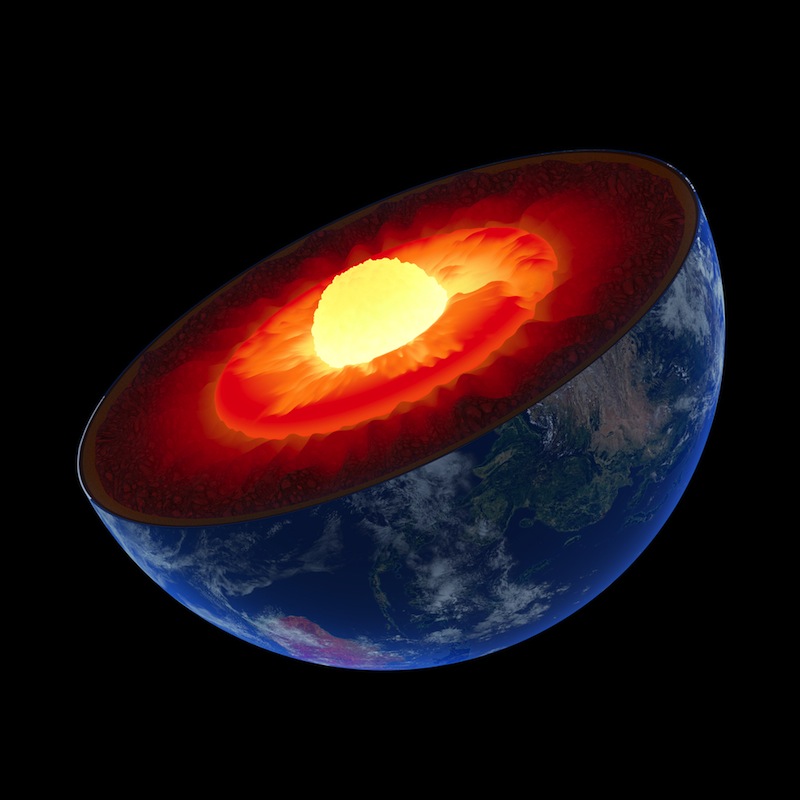Metal 'Snow' May Power Earth's Magnetic Field

The power source for Earth's magnetic field may be magnesium that has been trapped in the core since our planet's violent birth, a new model suggests.
Magnesium is the fourth most common element in the Earth's outer layers, but previously, scientists thought there was almost no magnesium in the core. Iron and magnesium don't easily mix, and researchers thought that the Earth's core was mostly iron.
However, that thinking has changed because of recent theories proposing that the Earth was born from a series of violent collisions with other protoplanets. During the impacts, temperatures and pressures were so intense that iron and metal could combine in an alloy, according to a study published today (Jan. 20) in the journal Nature. The study authors add that smashing together two planetary bodies likely injected magnesium into the core. About 1 percent of the core (by weight) could be magnesium, the new model shows. [Religion and Science: 6 Visions of Earth's Core]
"We think we now understand why the Earth has had a magnetic field for the last 4 billion years, and that the process will keep happening into the foreseeable future," said lead study author Joseph O'Rourke, a graduate student in planetary science at Caltech in Pasadena, California.
O'Rourke and study co-author Dave Stevenson, a Caltech professor, created a model of Earth's formation to investigate magnesium's behavior in the core. As Earth's core has slowly cooled, magnesium-oxide minerals are "snowing" out from the core's iron and nickel alloy, the model indicates. This solid magnesium "snow" is lighter than the liquid metal and floats outward through the liquid-metal outer core, churning it and powering the convection that produces the global magnetic field.
The new model could help solve an important question in planetary science: What has powered the Earth's magnetic field for the past 4 billion years? Many scientists think iron cooling and solidifying in Earth’s core generates the planet's magnetic field (also called the geodynamo). However, these models can't explain how the magnetic field was generated before the solid inner core formed about 1 billion years ago. The new magnesium model provides an alternative energy source.
With the new model, "you don't have to invoke anything crazy in the past to explain the geodynamo," O'Rourke told Live Science.
Sign up for the Live Science daily newsletter now
Get the world’s most fascinating discoveries delivered straight to your inbox.
The new model needs to be verified with experimental tests, the researchers said. There is little evidence indicating how magnesium behaves at the temperatures and pressures produced during planetary collisions.
"The idea is an interesting one," said Rebecca Fischer, a postdoctoral fellow at the Smithsonian Museum of Natural History in Washington, D.C., who was not involved in the study. However, "before we can really, conclusively say how much magnesium goes into the core, we need better experimental data," Fischer told Live Science.
One group is already conducting such experiments. James Badro, a geophysicist at the Institut de Physique du Globe in Paris, has led studies that simulate the early Earth and appear to confirm O'Rourke and Stevenson's modeling.
"There's enough data to convince us that our model of the magnesium process works in general, but sorting out a lot of the details will require more experiments," O'Rourke said.
A magnetic field is important for life because it shields the planet and the atmosphere from the solar wind. Knowing how ancient Earth's magnetic field kicked into gear may help improve estimates of when life first appeared and inform the search for life on other planets.
Follow us @livescience, Facebook & Google+. Original article on Live Science.










